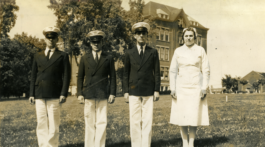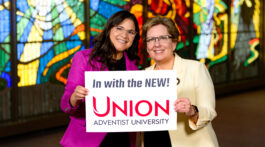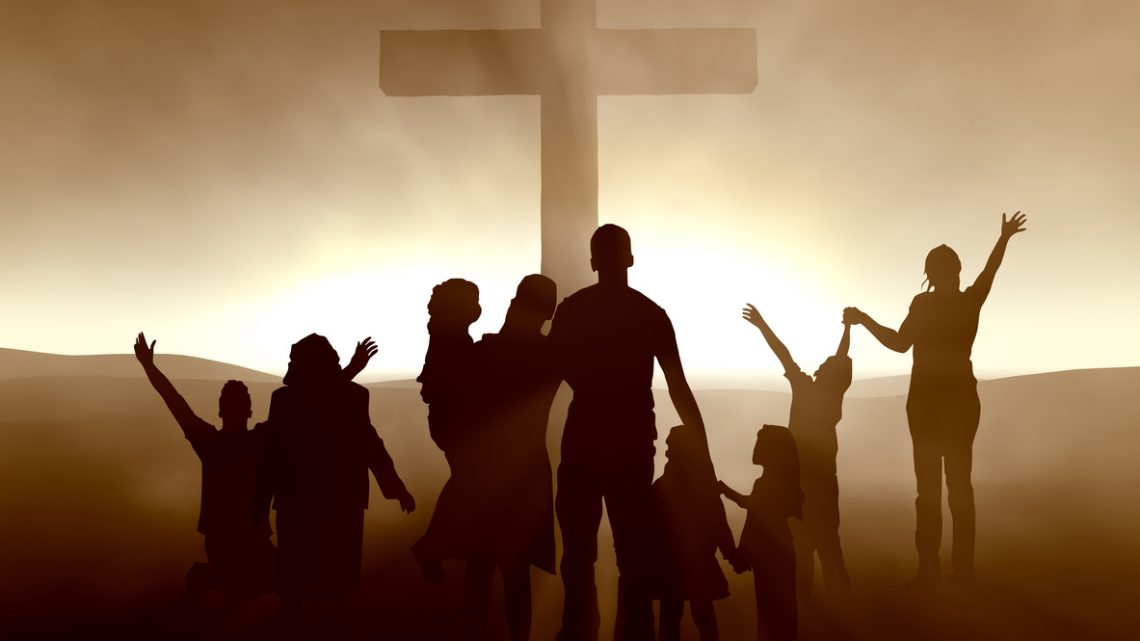Sabbath School Lesson for February 19-25, 2022
Overview of Lesson 9
The topic of sacrifice is shown in Hebrews, chapters 9 and 10, which we begin to explore this week. Jesus was shown to be the perfect Sacrifice, and our Bible study helped us realize…
- why there was the need for a sacrifice (Sunday)
- why many kinds of sacrifices were needed in the earthly sanctuary (Monday)
- what made Jesus’ sacrifice better (Tuesday)
- the purpose of the Day of Atonement (Wednesday)
- more about the character of God (Thursday)
We must understand that death by crucifixion was not a popular theme in the ancient world. As a matter of fact, any mention of the cross used in these cruel executions was seen as offensive. Anyone accused and sentenced to this kind of death on a tree was someone you definitely should avoid. Even Jews saw that manner of death as defiling (Deuteronomy 21:23).
To suggest that a divine being of any kind was killed this way would have been a difficult barrier for any discussion about the Son of God. Early paintings in the Christian catacombs were depictions of other symbols of salvation, such as a dove, a palm branch, or fish. The symbol of the cross, however, came later, as it was mostly seen by the world then as a sign of defeat and shame.
Memory Text: “For by one offering He has perfected forever those who are being sanctified.” Hebrews 10:14 NJKV
Paul seemed able to see the link between the cross and the gospel. He said in 1 Corinthians 1:18, “For the message of the cross is foolishness to those who are perishing, but to us who are being saved it is the power of God.” This helps us understand the mindset of those outside the Christian community. How we see the cross is vital to understanding the plan of salvation. It’s definitely the study of a lifetime and must be accepted by faith.
Sunday: Why Were Sacrifices Needed?
The ancient world was familiar with covenant agreements that involved the death of animals. In the Near East, for instance, when there was an exchange of promises between men or countries, it would often call for ratification by the sacrifice of some animal. This guaranteed the seriousness of the oaths taken, that death would result if promises were not kept.
God, therefore, used this practice when He made a covenant with Abraham. Genesis 15:6-21 describes a commonly-used ceremony of dead animals, but, instead of both parties in the agreement walking between the split animals, God was the only one to do it. This showed that God could be counted on to keep His promises. Abraham was to lean totally on God to make salvation work for him and his family. His promise to obey was meaningless without God’s promise to make salvation possible through the future death of His own Son.
The death of animals in Hebrew religion was used symbolically to point to the sacrificial death of the Messiah. The sprinkling of blood on the altar in the earthly sanctuary was a constant reminder of the Sacrifice needed to make our salvation secure.
Bible Verses to Explore:
Romans 3:21-26
- Why was the blood and death of Jesus necessary to make our salvation possible?
- What does God’s righteousness have to do with ours?
- What part does faith have in our salvation?
Monday: Diverse Kinds of Sacrifices
The many kinds of offerings in the earthly sanctuary helped educate the Hebrews about God, after years of slavery in Egypt.
- The holocaust or burnt offering meant that the whole animal was consumed on the altar (Leviticus 1). This represented, of course, Jesus’ total commitment to die for our sins.
- The grain offering showed their gratitude for God’s providential care (Leviticus 2). It also represented Jesus as “the bread of life”, and symbolized by the table of shewbread in the Holy Place of the sanctuary.
- The peace or fellowship offering was made when the burnt animal, all but its fat and blood, was used for food by the priests (Leviticus 3). It represented eating of His flesh and drinking of His blood, which later became the Lord’s supper that Christ celebrated with His disciples at the communal Passover dinner just prior to His death.
- The sin or purification offering had to do with the expiation, or doing away with, any unintentional sin they may have committed (Leviticus 4).
- The guilt or reparation offering provided forgiveness, but also called for some kind of reparation, or repairing any damage that sin may have caused (Leviticus 5).
Bible Verses to Explore:
Ephesians 3:14-19
- How does Jesus’ sacrifice exceed all of the offerings made in the earthly sanctuary?
- What and how are we to learn from Jesus’ Sacrifice?
Tuesday: Jesus’ Perfect Sacrifice
Hebrews 7:27 and 10:10 both mention that Jesus’ sacrifice was “once for all”. That’s because He was the perfect Sacrifice. And here’s why:
- The animal sacrifices had to be repeated whenever a sin was committed. See Hebrews 9:25 and 10:4.
- Jesus’ sacrifice cleanses and consecrates us so we can approach God ourselves. See Ephesians 3:12 and Hebrews 10:22.
- His sacrifice feeds our soul, giving us spiritual blessings like no other. See Hebrews 12:1, 2.
This “once for all” event was made possible when Jesus rose from the grave and went back to heaven to continue His ministry. Hebrews 7:23 reminds us that there were many Levitical priests, because they continued to die and were replaced. However, we are thankful and blessed because of the one perfect, eternal Sacrifice of our Lord and Savior.
Bible Verses to Explore:
Hebrews 7:27 and 10:10
- Why do we need Jesus as our “once for all” Sacrifice?
Hebrews 10:1-4
- What made the animal sacrifices insufficient and inferior to the sacrifice of Jesus?
Micah 6:6-9 and Psalm 51:17-19
- Why was God not pleased with the animal sacrifices in the days of Micah?
- What kind of sacrifice does God require of us?
Wednesday: The Cross and the Cost of Forgiveness
In order to understand the last part of Hebrews 9, we really should be familiar with the symbolism of the sanctuary and its ceremonies. After all, the sanctuary represented God’s administration and character, being a copy of the one in heaven (Hebrews 9:23).
Since the sanctuary was a place where sins were forgiven and then transferred to the inner rooms of the tabernacle, the Day of Atonement, once a year, was needed to cleanse the sanctuary. On that day, God’s judicial duties were revealed by having those sins transferred to the scapegoat, which represented Satan.
Christ’s work did not end with His sacrifice on the cross, which made our forgiveness possible. The two-phase system of the temple services informs us that there is more work to be done. God’s justice must also be revealed. He must be seen as loving, but also fair. The day of judgment, illustrated by the Day of Atonement, served that purpose.
The cleansing of the heavenly sanctuary is needed to let the universe know that God is capable of taking care of sin and Satan. Satan, the symbolic scapegoat, will be held accountable for all the sins he has committed and encouraged others to commit. The cost for his rebellion will be on full display.
Bible Verses to Explore:
Hebrews 9:22-28
- Even though Christ only died once to pay the price of sin, why was it still a high cost to pay?
Thursday: Judgment and the Character of God
The earthly sanctuary services operated with the object of showing us God’s character, so we could grow more like Him. Salvation was illustrated symbolically by the sacrifices made daily to have our sins forgiven.
Those forgiven sins, however, represented by the blood that was shed and carried into the tabernacle, was not enough. For a full understanding of God’s plan to save us, the services also included a Day of Atonement, or judgment, that was needed to cleanse the sanctuary and fully get rid of those sins.
God’s character consists of two traits that are repeatedly mentioned throughout the Bible: His justice and His mercy (Psalm 103:6-8). Jesus’ sacrifice on the cross revealed His mercy and all-encompassing love for even the worst of sinners. But it will be at the Judgment, at the end of the millennium mentioned in Revelation, that God’s justice will be shown and eternally appreciated.
This judgment must begin before Christ comes again, and that is why many believe that Jesus is engaging in a pre-Advent judgment in the heavenly sanctuary. This work must be done to secure the salvation of God’s children and determine the fate of those who are not safe to save (Revelation 22:12).
Bible Verses to Explore:
Romans 3:21-26 and 5:8
- How is God’s love and justice shown through what Christ has done for us?
- While God loves us, even when we are sinners, what prevents Him from saving all of us?
Friday: Conclusion
Although Jesus is our perfect Sacrifice, our only means of salvation and eternal life, there are ways we can show our appreciation for God’s unconditional love.
Jesus asks that His followers take up their cross and follow Him (Matthew 16:24). In other words, there will be times when we are called to suffer trials and difficulties for His sake. We are privileged to share in His sufferings by bearing it with the same grace and patience He was given from the Father.
Paul also reminds us of our duty to be “a living sacrifice” to God (Romans 12:1). We can submit our bodies to Him and allow our clean, holy lifestyles to be a witness for God. Our service to Him shows that we willingly belong to Him. We sacrifice our hearts and submit our whole body, mind, and soul to His will and Kingdom.
Hebrews 13:15, 16 speaks of such sacrifice on our part:
“Therefore by Him let us continually offer the sacrifice of praise to God, that is, the fruit of our lips, giving thanks to His name. But do not forget to do good and to share, for with such sacrifices God is well pleased.”
So, by our words and actions, God’s perfect Sacrifice becomes part of our lives, evidence that we accept His Sacrifice and look forward to sharing His glory in that eternal homeland called heaven.
Here’s a music offering of praise to God that expresses our thanks to Him… https://www.youtube.com/watch?v=Hs05AtP2wd8
Next Week: Jesus Opens the Way Through the Veil
To read the Sabbath School Lesson Quarterly or see more resources for its study, go to










